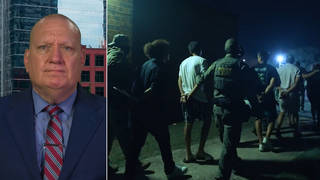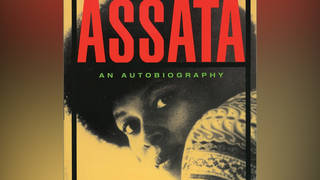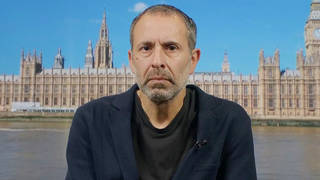
Ruben Cantu was the fifth teenager convicted and executed by the state of Texas. Now more than a dozen years after his death, a further investigation into his case has provided new information supporting his unwavering claim to innocence. We speak with Lise Olsen, the reporter from the Houston Chronicle who has written a series of articles on the case. [includes rush transcript]
We turn now to another state execution. In 1993, the state of Texas executed Ruben Cantu. He was convicted at the age of 18 and only 26 years old when killed by lethal injection. Canto was charged with committing murder and robbery. During his eight years on death row Cantu maintained his innocence. Just four days after his sentencing, Cantu wrote in a letter addressed to the citizens of San Antonio: “I have been framed in a capital murder case.” In 1987, he wrote to the Board of Pardons and Paroles, saying, “I was tried and convicted on bogus evidence.”
Now more than a dozen years after his execution it appears he was telling the truth. The single eyewitness has recanted his testimony against Cantu. And Cantu’s alleged co-defendent has signed an affidavit saying he allowed his friend to be falsely accused.
- Lise Olsen, Houston Chronicle reporter who has been investigating this case.
Transcript
AMY GOODMAN: We turn now to the Houston Chronicle reporter who has been investigating this case. Lise Olsen joins us from Houston. Welcome to Democracy Now!
LISE OLSEN: Thank you, Amy.
AMY GOODMAN: It’s good to have you with us. And sorry for my laryngitis. Can you lay out for us the story of Ruben Cantu?
LISE OLSEN: Well, Ruben Cantu was a teenager growing up in the south part of San Antonio in the barrio, and he attended special education classes at South San High School. He also was a member of a group of neighborhood teens that they called the Grey Eagles, ran around on the streets with other kids. His parents were divorced. He got involved in stealing cars. He was known by neighborhood cops as a kid who got in trouble, and there was a murder that occurred right across the street from his house, and when that happened, he was one of the first kids that they looked at.
AMY GOODMAN: And explain what took place, why he was arrested for murder.
LISE OLSEN: Well, he was initially looked at as a suspect, I think, mainly because he lives across the street from the murder. And the murder victim was with another man in a vacant house that was under construction. The second man who survived, barely, what was a robbery and murder initially did not identify Ruben, but told police that there were two teenagers who attacked him, one who was older, a little bit older, 17-18, and one who was younger, and all he said initially to the officers was he thought they were teens from the neighborhood. So they showed him a lot of mugshots of kids from the neighborhood while he was still in the hospital. This victim, his name is Juan Moreno, was only 19 years old, had barely survived and was very critically injured, and initially he did not identify Ruben Cantu.
A couple months passed and Ruben was involved in an argument with an off-duty police officer in a bar called the Scabaroo Lounge, also in South San Antonio. And during that altercation — the officer actually says there wasn’t a fight, but Ruben Cantu’s version and other people’s version that night was that there was a fight. The officer was shot. Ruben’s version, again, was that he did not know that this man was a police officer. Joe De La Luz, the officer who was shot, was not in uniform, he was not on duty, he was carrying two concealed weapons.
But what happened was the next day, the sergeant in charge of the homicide case again sent an officer out to talk with the surviving witness in the unrelated murder that happened previously, showed the witness again the photo of Ruben Cantu. On the second pass, the witness again refused to identify Ruben as the shooter. The third day the same sergeant again sent an officer out to question Juan Moreno, and on this third pass, this time this 19-year-old boy did identify Ruben Cantu as the shooter and went on to be the only witness in the capital murder trial against Ruben Cantu, not the only witness, but the only eyewitness, because the co-defendant, who was also identified by Juan Moreno and arrested shortly after that, never testified against Ruben Cantu or gave a statement about the murder at all.
AMY GOODMAN: We’re talking to Lise Olsen, reporter at the Houston Chronicle, about the case of Ruben Cantu. Can talk about all the statements he made once he was in prison?
LISE OLSEN: Well, Ruben Cantu consistently told both his lawyers and his family that, yes, indeed, he shot the police officer, but he had nothing to do with the murder for which he was convicted and sentenced to death. He said that he was in Waco, Texas, at the time, which is almost 200 miles away from San Antonio. But the people who were supposedly with Ruben were not found and interviewed by his attorneys before his trial. They did find one woman who claimed to be the person who hosted Ruben, while this trip occurred, but they never found these other brothers that he always said he was with.
And he also said openly, as you read in that letter, that he had been framed. He felt that the officers had framed him for murder, because he had shot this other police officer, and it is true that the sergeant who was working on this case, the murder case, was a very close friend of the police officer who was shot, and he said to me that we could not get him for the other crime, that we got him for this murder. He admitted that the case took the turn it did, because of the police shooting, and he refocused the investigation on Ruben Cantu, because of what happened in the Scabaroo Lounge, the unrelated incident.
AMY GOODMAN: And so, today, the officials who are admitting that they made a mistake, can you go through the list, from the judge to the prosecutor to the chair of the jury?
LISE OLSEN: Well, I — before I published this story, I took the information that I had gathered to the key players that you mentioned, and everyone had a reaction of dismay. They were all uniformly concerned about how this could happen. The lead juror, the foreman of the jury, said, you know, 'We all had our fingers in this. The wrong man was executed.' The defense attorney, who is now a judge, said, 'I was always upset about this process. It was — of the identification of Ruben Cantu. I always thought the court should overturn his conviction, and this just makes it that much worse.' The D.A. said, 'Looking back, this never should have been a death penalty case. This was a teenager. This was not the kind of evidence that we would have needed really to justify a death penalty case.' And even the judge, who is more reluctant to believe that Ruben Cantu might have been innocent, says, 'This is a disturbing case. There seems to be a lot of problems. Why is it that these things did not come out before Ruben was executed?'
AMY GOODMAN: Why didn’t they come out? How did you break this story?
LISE OLSEN: Well, I think there were a combination of things that happened. One is that Ruben Cantu, himself, was a very, very quiet person and didn’t tell his lawyers things that he knew that could have helped him and help them find the other people. Another factor is that the lawyer he had on appeal, even though she is a very good criminal attorney, had never handled a death penalty case at the time, did not have the resources to hire a crack investigator to find either Juan Moreno or to find the people that Ruben Cantu was with, said he was with on the night of the murder. So they were never re-interviewed or found before Ruben Cantu’s death. The co-defendant, David Garza, who has come forward and named someone else now as the murderer, never previously gave a statement. He wrote to Nancy Barohn, the attorney, and asked her to come and visit him a month before Ruben’s execution. But, at that point, she was so swamped with deadlines for the Supreme Court, the Fifth Circuit, and the commutation hearing, that she did not go to see him. He wasn’t explicit in his letter, and she didn’t really believe that he had information that could have exonerated or helped to try to put forward an innocence claim at the last minute for Ruben Cantu.
AMY GOODMAN:How about Ruben Cantu’s mother? Is she still alive?
LISE OLSEN:Ruben Cantu’s mother is indeed still alive, and inside the doorway of her house in Floresville, Texas, there’s a sort of an altar/monument to Ruben: two pictures she took of him on the day he was executed that she looks at every day. She was outside the night he was executed in a candlelight vigil. She has always maintained that her son was innocent and died innocent.
AMY GOODMAN:Is she bringing a suit in this case?
LISE OLSEN:Not that I know of. What’s happening in this case right now is the district attorney, Susan Reed, is reinvestigating. She says she’s determined to try to figure out what happened, look at everything that was done in the case and decide if there are other criminal charges that might need to be brought.
AMY GOODMAN:Lise Olsen, you’re a reporter for the Houston Chronicle. Before that you worked for the Seattle Post-Intelligencer in Seattle. You did a long series of pieces there on how the death penalty is dealt with in the State of Washington. Can you end with that?
LISE OLSEN:Well, in Washington one of the things I found in my series was that the level of representation after a conviction, or even before a conviction at trial, is widely variable, even in a state like Washington where there is a small number of cases and greater resources dedicated to that area. There is everything from lawyers who had been disbarred to lawyers who were drunk handling death row cases and there, there was a significant reform undertaken after this series ran. Texas has largely the same system Washington does where the judges mainly decide who gets appointed to a death row case on the state level; and that is where, under our current law, actual innocence claims need to be raised, at the state writ level. So if you’re someone like Ruben Cantu and you have a very complicated actual innocence claim, you may or may not get a lawyer who has the resources or the experience to actually investigate it and bring it before the courts. And that has not changed.
AMY GOODMAN: Where you are, Texas and California have the largest death rows in the country. Is that right?
LISE OLSEN:Yes, that’s right.
AMY GOODMAN: And the recommendations that the State of Washington, the Supreme Court, implemented after your series?
AMY GOODMAN: They established a — They had a process to screen death row lawyers for quality for death penalty cases. They expanded that and made it mandatory. They used to have a recommended list, so that judges could pick qualified attorneys if they chose. The supreme — the Chief Justice of the Supreme Court in Washington is a very conscientious man, Gary Alexander, set up a committee to look at this issue; and he decided that what needed to happen was that needed — that list needed to be mandatory, so that in Washington today, the attorneys who handle death penalty appeal cases are screened by a blue ribbon committee of lawyers who not only consider how many years of experience they have, but look at the quality of their briefs, what kinds of mistakes or gains — or wins they’ve had during their careers and they are very thoroughly scrutinized.
AMY GOODMAN: Lise Olsen, I want to thank you for being with us. Reporter at the Houston Chronicle, formerly with the Seattle Post-Intelligencer, thank you for joining us. This fact: Since the death penalty has been reinstated in this country, over the last 20 years, on average a person is executed once every 10 days.












Media Options